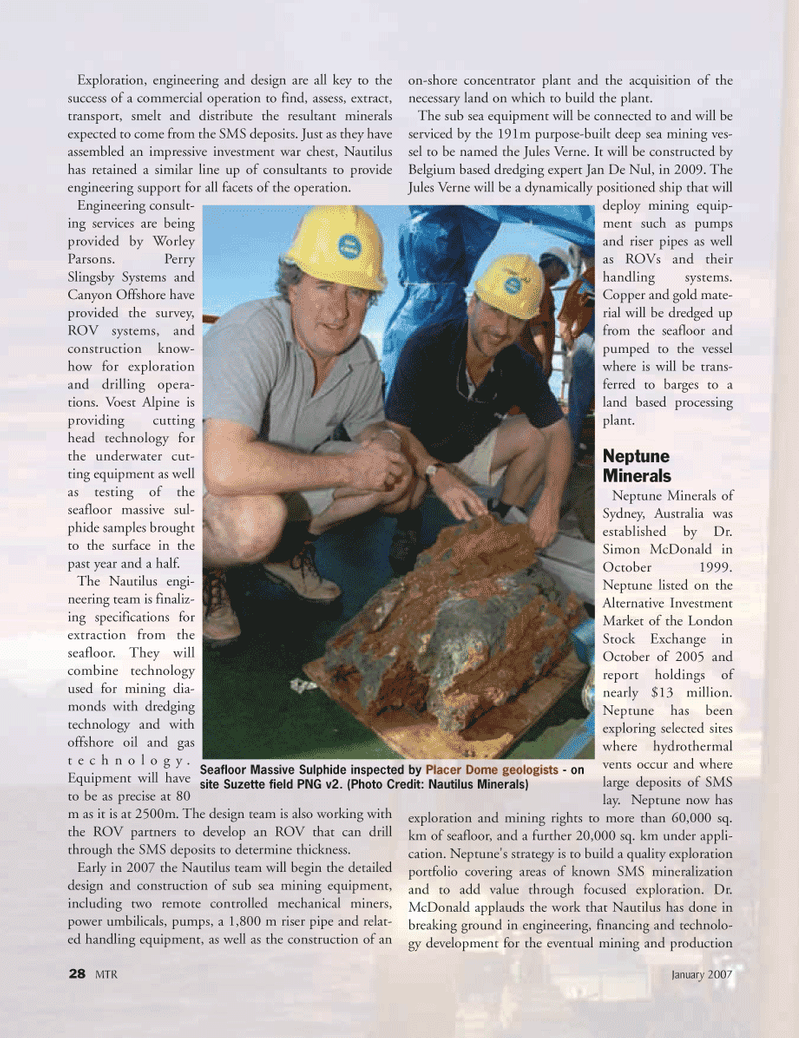
Page 28: of Marine Technology Magazine (January 2007)
Seafloor Engineering
Read this page in Pdf, Flash or Html5 edition of January 2007 Marine Technology Magazine
28 MTR January 2007
Exploration, engineering and design are all key to the success of a commercial operation to find, assess, extract, transport, smelt and distribute the resultant minerals expected to come from the SMS deposits. Just as they have assembled an impressive investment war chest, Nautilus has retained a similar line up of consultants to provide engineering support for all facets of the operation.
Engineering consult- ing services are being provided by Worley
Parsons. Perry
Slingsby Systems and
Canyon Offshore have provided the survey,
ROV systems, and construction know- how for exploration and drilling opera- tions. Voest Alpine is providing cutting head technology for the underwater cut- ting equipment as well as testing of the seafloor massive sul- phide samples brought to the surface in the past year and a half.
The Nautilus engi- neering team is finaliz- ing specifications for extraction from the seafloor. They will combine technology used for mining dia- monds with dredging technology and with offshore oil and gas technology.
Equipment will have to be as precise at 80 m as it is at 2500m. The design team is also working with the ROV partners to develop an ROV that can drill through the SMS deposits to determine thickness.
Early in 2007 the Nautilus team will begin the detailed design and construction of sub sea mining equipment, including two remote controlled mechanical miners, power umbilicals, pumps, a 1,800 m riser pipe and relat- ed handling equipment, as well as the construction of an on-shore concentrator plant and the acquisition of the necessary land on which to build the plant.
The sub sea equipment will be connected to and will be serviced by the 191m purpose-built deep sea mining ves- sel to be named the Jules Verne. It will be constructed by
Belgium based dredging expert Jan De Nul, in 2009. The
Jules Verne will be a dynamically positioned ship that will deploy mining equip- ment such as pumps and riser pipes as well as ROVs and their handling systems.
Copper and gold mate- rial will be dredged up from the seafloor and pumped to the vessel where is will be trans- ferred to barges to a land based processing plant.
Neptune
Minerals
Neptune Minerals of
Sydney, Australia was established by Dr.
Simon McDonald in
October 1999.
Neptune listed on the
Alternative Investment
Market of the London
Stock Exchange in
October of 2005 and report holdings of nearly $13 million.
Neptune has been exploring selected sites where hydrothermal vents occur and where large deposits of SMS lay. Neptune now has exploration and mining rights to more than 60,000 sq. km of seafloor, and a further 20,000 sq. km under appli- cation. Neptune's strategy is to build a quality exploration portfolio covering areas of known SMS mineralization and to add value through focused exploration. Dr.
McDonald applauds the work that Nautilus has done in breaking ground in engineering, financing and technolo- gy development for the eventual mining and production
Seafloor Massive Sulphide inspected by Placer Dome geologists - on site Suzette field PNG v2. (Photo Credit: Nautilus Minerals)
MTR#1 (17-32).qxd 1/11/2007 4:03 PM Page 28

 27
27

 29
29
